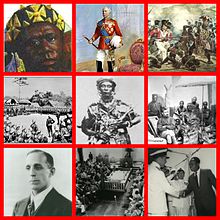
| History of Ghana |
|---|
| Timeline |
|
| By topic |
|
|
The area of the Republic of Ghana (the then Gold Coast) became known in Europe and Arabia as the Ghana Empire after the title of its Emperor, the Ghana.[1] Geographically, the ancient Ghana Empire was approximately 500 miles (800 km) north and west of the modern state of Ghana, and controlled territories in the area of the Sénégal River and east towards the Niger rivers, in modern Senegal, Mauritania and Mali.[2] The empire appears to have broken up following the 1076 conquest by the Almoravid[3] General Abu-Bakr Ibn-Umar. A reduced kingdom continued to exist after Almoravid rule ended, and the kingdom was later incorporated into subsequent Sahelian empires, such as the Mali Empire.[4] Around the same time, south of the Mali empire in present-day northern Ghana, the Kingdom of Dagbon emerged.[5] The decentralised states ruled by the tindaamba were unified into a kingdom.[6][7] Many sub-kingdoms would later arise from Dagbon including the Mossi Kingdoms[8] of Burkina Faso[9] and Bouna Kingdom[10] of Ivory Coast.[11] Dagbon pioneered Ghana's earliest learning institutions,[12] including a university town,[13] and a writing system prior to European arrival.[14]
Toward the end of the classical era, larger regional kingdoms had formed in West Africa, one of which was the Kingdom of Ghana, north of what is today the nation of Ghana.[15] Before its fall at the beginning of the 10th century, Akans migrated southward and founded several nation-states around their matriclans, including the first empire of Bono state founded in the 11th century and for which the Brong-Ahafo (Bono Ahafo) region is named.[16] The Mole-Dagbon people, who founded the earliest centralised political kingdoms of Ghana, migrated from Lake Chad to present-day Ghana. Later, Akan ethnic groups such as the Ashanti, Akwamu, Akyem, Fante state and others are thought to possibly have roots in the original Bono state settlement at Bono Manso.[17] The Ashanti kingdom's government operated first as a loose network and eventually as a centralized empire-kingdom with an advanced, highly specialized bureaucracy centred on the capital Kumasi.[18]
- ^ Abaka, Edmund (27 April 2010), "Ghana Empire", African American Studies Center, Oxford University Press, doi:10.1093/acref/9780195301731.013.47874, ISBN 978-0-19-530173-1.
- ^ "Kingdom of Ghana [ushistory.org]". us history. Retrieved 21 January 2020.
- ^ "3: Islam in West Africa. Introduction, spread and effects – History Textbook". Retrieved 21 January 2020.
- ^ "Supplementum Epigraphicum GraecumBosporos. Aspects of The Bosporan Kingdom in the later Roman empire". Supplementum Epigraphicum Graecum. doi:10.1163/1874-6772_seg_a27_424.
- ^ Staniland, Martin (1975). The Lions of Dagbon: Political Change in Northern Ghana. doi:10.1017/CBO9780511759543. ISBN 9780521206822.
- ^ "2-3: The Origins of Dagbon". adrummerstestament. Retrieved 12 October 2023.
- ^ Staniland, Martin (1975). The Lions of Dagbon: Political Change in Northern Ghana. African Studies. Cambridge: Cambridge University Press. ISBN 978-0-521-10143-1.
- ^ "Mossi-Dagomba". GlobalSecurity. Retrieved 12 October 2023.
- ^ Debutify (30 January 2021). "The Rise & Fall of The Powerful Mossi Kingdoms". Our Ancestories. Retrieved 12 October 2023.
- ^ "Bouna | African kingdom | Britannica". Britannica. Retrieved 12 October 2023.
- ^ "Rezo-Ivoire .net | le royaume koulango de bouna". rezoivoire. Retrieved 12 October 2023.
- ^ Kea, Ray (February 2018). "Science and Technology in 18th Century Moliyili ) Dagomba) and the Timbuktiu Intellectual Tradition".
- ^ Lauer, Helen (November 2007). "Depreciating African Political Culture". Journal of Black Studies. 38 (2): 288–307. doi:10.1177/0021934706286905. ISSN 0021-9347. S2CID 146634078.
- ^ "Dagbanli Ajami and Arabic Manuscripts of Northern Ghana". open.bu.edu. Retrieved 12 October 2023.
- ^ Baafi, Ernest; Carey, Edward E.; Blay, Essie T.; Ofori, Kwadwo; Gracen, Vernon E.; Manu-Aduening, Joe (20 June 2016). "Genetic incompatibilities in sweetpotato and implications for breeding end-user preferred traits". Australian Journal of Crop Science. 10 (6): 887–894. doi:10.21475/ajcs.2016.10.06.p7618. ISSN 1835-2693.
- ^ Boafo, James (2019). Agrarian transformation in Ghana's Brong Ahafo region: Drivers and outcomes (Thesis). University of Queensland Library. doi:10.14264/uql.2019.711.
- ^ Meyerowitz, Eva L. R. (1975). The Early History of the Akan States of Ghana. Red Candle Press. ISBN 9780608390352.
- ^ Andrews, Rhys (2013). "Representative bureaucracy in the United Kingdom". Representative Bureaucracy in Action: 156–167. doi:10.4337/9780857935991.00017. ISBN 9780857935991.